Alex Stewart uses TransferLab to identify players lighting up the Campeonato Brasileiro Série A and who could make it in Europe
With over three quarters of the season played in Brazil, it’s a good time to evaluate the league’s talent with a view to potential transfer activity. For UK-based clubs, this is especially true. The Brasileirão is winter league, which means that clubs are likely to be more amenable to January bids from European clubs. In addition, the post-Brexit GBE rules strongly favour new markets like Brazil. While it might previously have been difficult to secure work permits for Brazilians not in the national side or with dual nationality, this is no longer the case. GBE points are awarded for top continental competitions like the Copa Libertadores, and South America’s showpiece is banded with the Champions League, meaning a player who plays 90-100% of their club’s available minutes in that competition is already two-thirds of the way to a permit.
Of course, we have yet to see a huge influx of Brazilians, outside those like Casemiro who have been established in Europe for a long time already. Brexitball expert Andy Watson observed in a recent piece for Analytics FC that “there can be little doubt that players in those [Band 3 leagues] are technically good enough to play at the level required in the Premier League and, especially, The Championship, so there are probably other reasons that clubs feel like they aren’t ready to shop in that market. That could be, in part, the lack of evidence that players coming [directly] from those leagues can adapt.”
But Andy went on to say, “I would be shocked if we don’t see this market continue to open up in the next few windows, especially if there is little change in the regulations.”
With that in mind, let’s use TransferLab to delve into Brazil’s top tier and find some players worth looking at for clubs in the UK.
Best XI
TransferLab’s Best XI tool is an extremely handy way to start the process. Selecting a 4-3-3 and showing three players per position, we then filtered by age and minutes played. We are only interested in players 25-years-old or younger, and we also have a 700 minutes played threshold (this is partly for data integrity and partly for work permit reasons). Lastly, we select Auto Pass or Eligible for the GBE criteria, which means that all the players shown meet or exceed the 15 points requirement for a permit (you can find a clear explainer of the rules and some background here).
The numbers shown next to each player’s name are their tier scores: that score is arrived by comparing to other players in their tier, which for the Brasileirão is Tier 2 (like the Championship, Eredivisie, or Portugal’s Primeira Liga). Any players achieving 80 or above would be considered among the best 20% of players in that position in that tier based on whichever positional profile was chosen – for this exercise, we’ve gone for all-rounders in every position. Immediately, then, a few positions stand out: centre back, central midfield, and centre forward. And, while we aren’t going to look at them, Atlético Mineiro right-back Guga and Santos’ Venezuelan winger Yeferson Soteldo are also super players who wouldn’t look out of place in a European top five league.
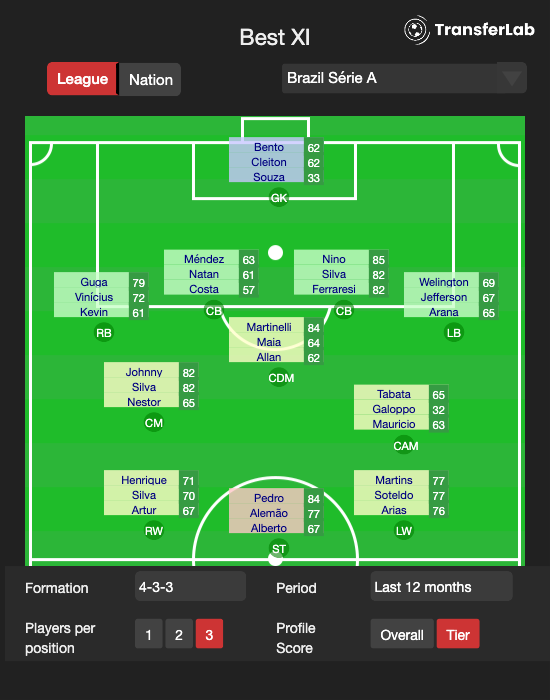
But now, let’s dive into our selections.
Nino
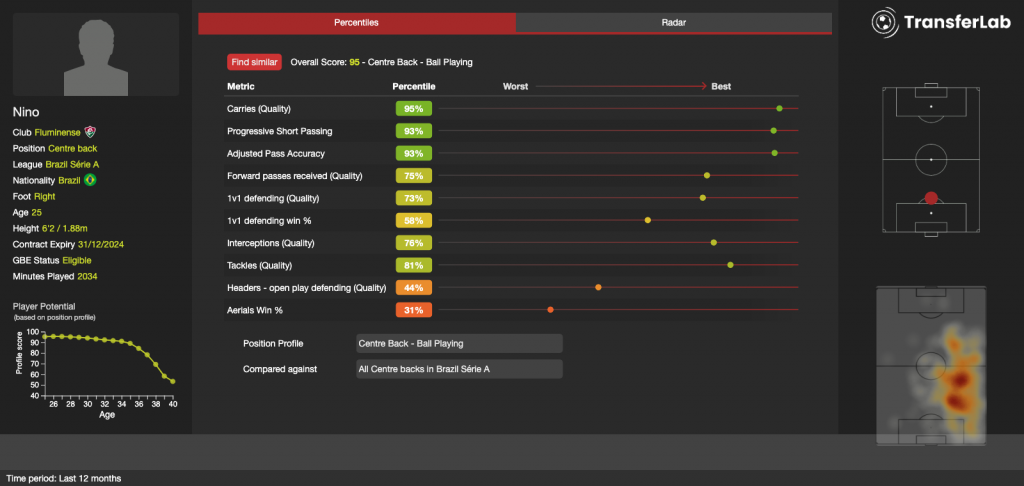
Nino is captain of Fluminense, the tactically unorthodox and scintillating team managed by Fernando Diniz. Diniz’s system is extremely narrow and vertically compact and uses rotations and high tempo, short passing to overwhelm the opposition through the thirds. But it starts with deep build-up patterns and Nino is key to this.
The 25-year old is a high volume passing centre back, capable of making thrusting runs forwards with the ball too.
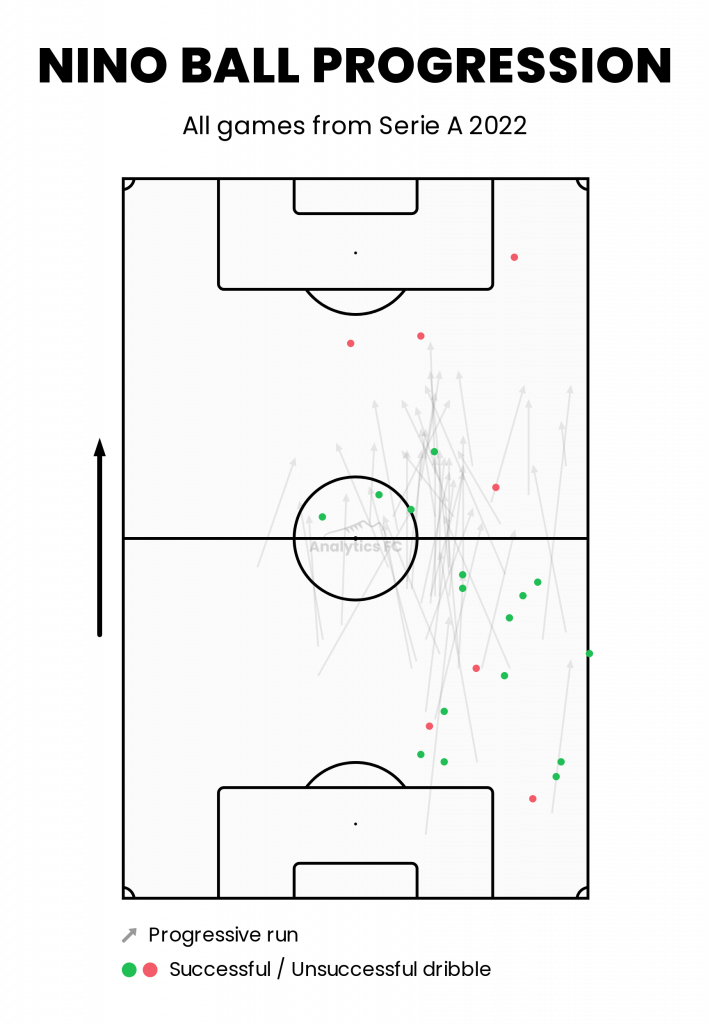
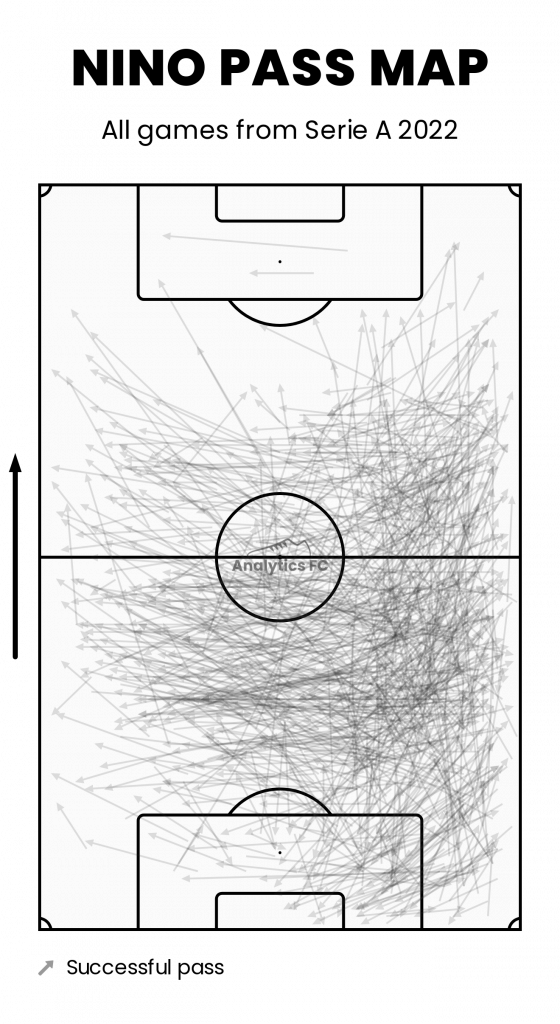
As you can see from the pass map above, Nino is responsible for a huge amount of ball circulation in the low and middle thirds, but he can also use a greater passing range to open up the wide areas for Fluminense wide attackers, or when the striker runs out towards the touchline.
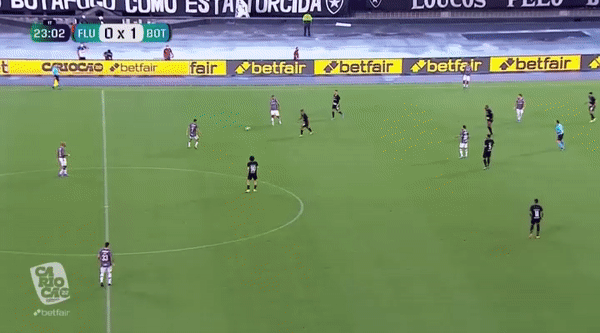
He’s also adept at drilling lower passes through the opposition lines and his awareness of passing opportunities is good, as it must be given Diniz’s predilection for rotations and quirky off-the-ball running.
Defensively, Nino is proactive and occasionally overruns a challenge or gets caught out of position. But he’s reasonably quick and can make decent recovery runs.
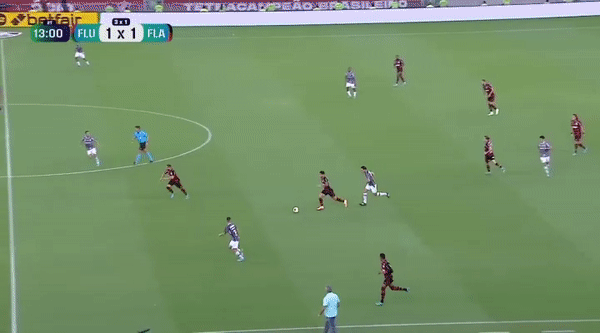
He’s also aggressive in the air and has a rugged physicality that would add some steel to any team. He has clear leadership qualities, as shown by his captaincy role, and working well under a tactically innovative coach suggests intelligence, game awareness, and versatility. In short, Nino is an excellent centre back, who has some international experience, playing in the final as Brazil won Gold at the Summer Olympics in 2020. Progressive, passing centre backs are very much in fashion, but Nino has solid defensive fundamentals as well, which make him a genuine prospect for a transfer to a stronger league in Europe.
TransferLab’s similar players function highlights Manchester United’s Lisandro Martinez, Arsenal’s William Saliba, and Milan Pierre Kalulu as players who profile very similarly to Nino, while the closest match is Torino’s Perr Schurrs. These are all aggressive defenders who can pass and carry, which shows the kind of quality company that Nino could keep if he moved to Europe.
Pedro

A former Best Newcomer at the Prêmio Craque do Brasileirão, Pedro was released by Flamengo as a teenager, made a name for himself at rivals Fluminense, and is now back where it all began and scoring well. He did have the briefest of stints in Europe, at Fiorentina, but was unable to force his way into the starting line-up and departed swiftly for a loan spell at Flamengo that was the catalyst for his current success. That does suggest a certain caveat, but an older, more mature Pedro is showing that he has what it takes to make it in a top five league.
Flamengo tend to play with a 4-3-1-2, and Pedro is part of a fluid front three but tends to act more as the focal point. While he does drop off to link play sometimes, or peels wide to run the left channel, you’ll most likely find him on the shoulder of the last defender. As Flamengo progess the ball, he makes little, stop-start runs to keep himself onside and gain fractions of space away from markers. His height makes him a handful, and he’s very good in the air, which means he can win flick-ons to release other players ahead of him, or hold the ball up.
But he’s mostly a predator. In and around the six yard area, his strength, height, and movement make him difficult to mark, and it’s no surprise that most of his goals and his assists come from central, and close, areas.
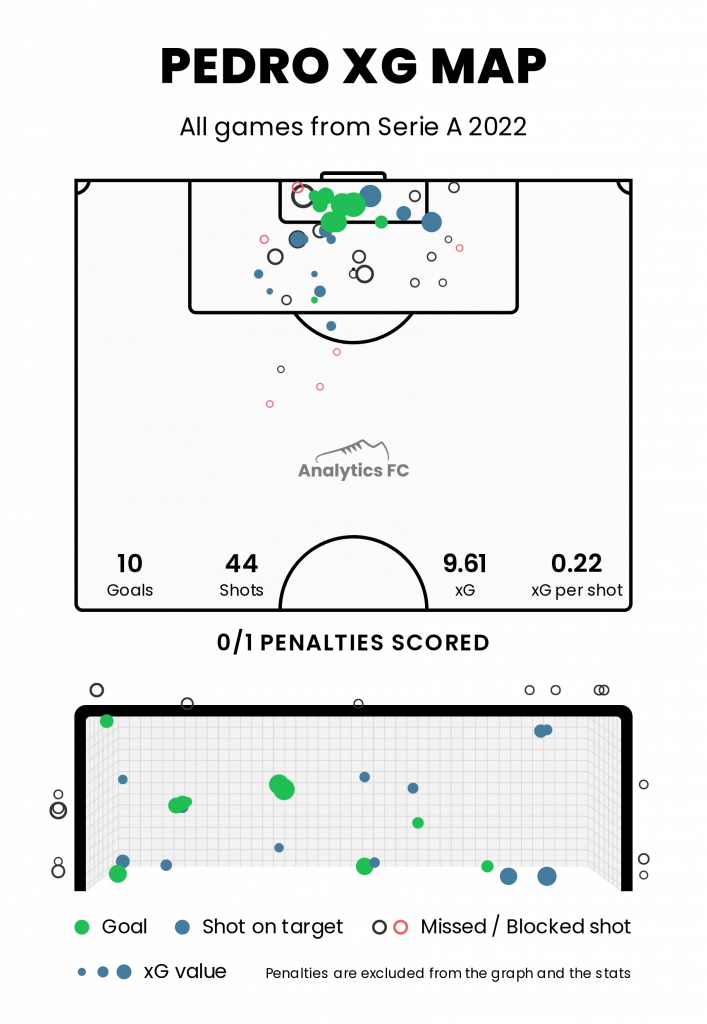

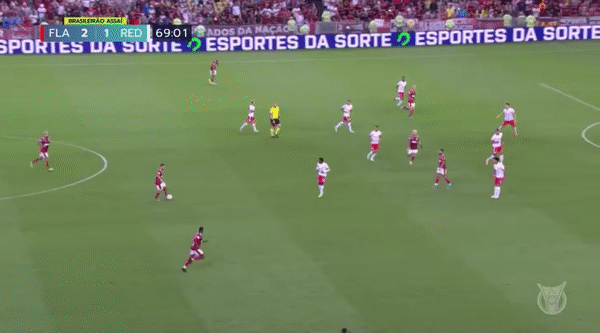
He also has a powerful shot, and his ability to find space makes him dangerous in the box in slightly deeper positions too.
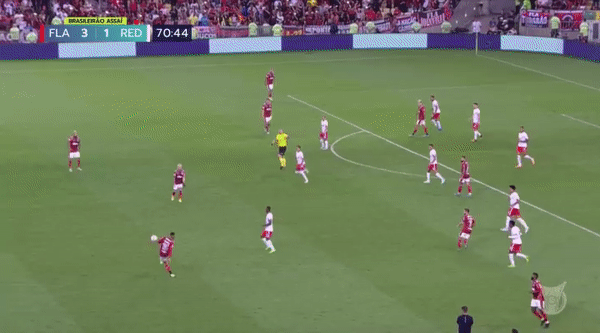
Pedro is not an especially refined player when it comes to linking moves or deftly assisting his fellow attackers, but as a focal point in the centre, he could do a fine job for sides that want a robust presence to feed off tricky wide attackers or good, progressive central passers. His movement and physicality make him tricky to defend against and his ability to score, while not always elegant, is effective.
Using TransferLab’s similarity tool, we can see that Pedro profiles most like Lens’ Loïs Openda, another forward who gets a lot of touches in the box and receives a lot of passes, but contributes less in the way of creativity himself.
Martinelli
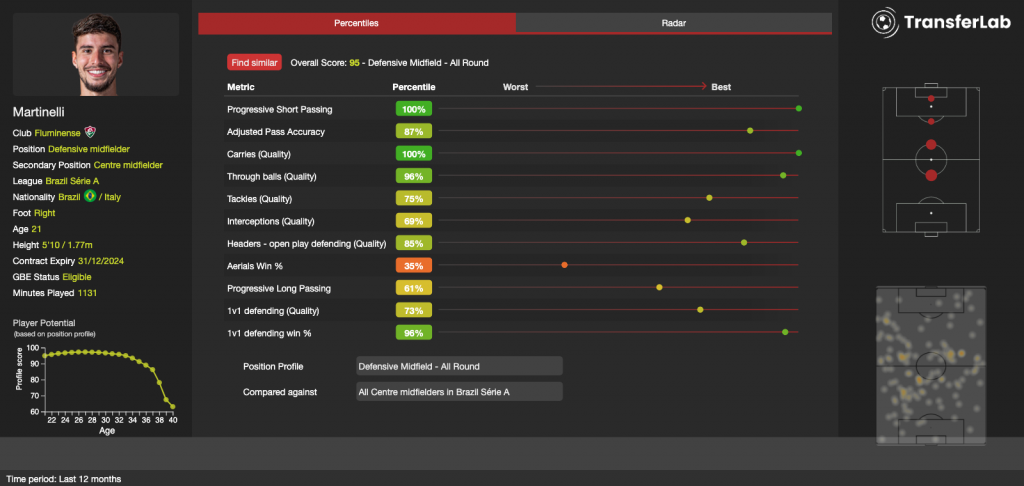
This one is for all you Football Manager fans – Martinelli is an FM23 ‘wonderkid’ and with good reason. The 21-year-old Fluminense midfielder, who can play as a six or eight, is an all-round, all-action midfielder, as capable of pulling off a deft through ball as he is able to break up play and shield a back line.
Here’s one of those passes, for reference.

As his TransferLab profile shows, Martinelli’s sole real weakness is aerial duelling; otherwise, he’s in the top 5% of all Brasileirão midfielders for passing, carrying, through balls, and 1v1 defending. That’s quite a skill-set, especially for a 21-year-old. He’s also racked up over 4300 minutes in three seasons since debuting at 18, and that’s a pretty solid indicator of lasting quality.
There are a few caveats: Fluminense’s style requires a lot of activity from midfielders, and Martinelli’s heatmap shows someone who is all over the pitch, which might translate to him needing to knuckle down to one specific position for a less tactically idiosyncratic team.

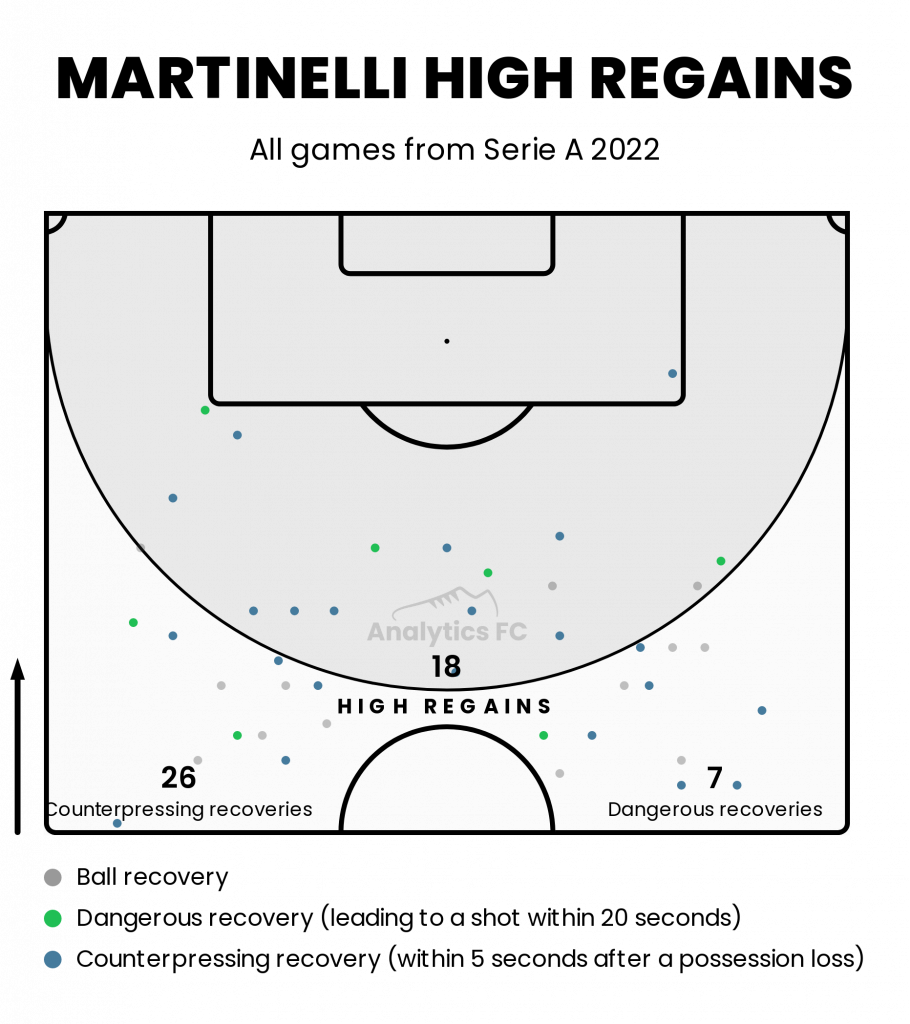
All that being said, Martinelli is a player who genuinely could evolve into one of the finest midfielders in the world. His passing numbers remain in the top 5-10% even when compared against current Tier 1 players, that is, players in Europe’s top five leagues. Add in his dynamism in the press, and the kind of tactical and positional awareness required to hold down a key starting role in that Fluminense side, and you have a very well-rounded player already who has huge room to grow. TransferLab’s similar player function flags up some genuinely excellent players, including deep playmakers like Milan’s Ismaël Bennacer, pressing machines like Leeds’ Tyler Adams, and my favourite all-rounder, Ibrahim Sangaré.

Profiling do-it-all midfielders, and finding similar players, is tricky, but the above gives some indicator of just how good Martinelli could be.
Johnny

Another 21-year-old midfielder with the potential to excel in Europe? Here’s Internacional’s Johnny, an all-action central midfielder. Johnny is less defensively-minded than Martinelli, and lacks his capacity for through balls, but is a dynamic, linking presence.
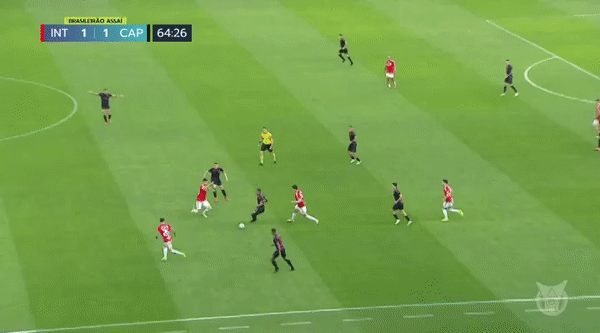
Johnny has operated on the right hand side of a midfield double pivot in a 4-2-3-1, or the anchoring player in a midfield diamond. That versatility is impressive, especially as he likes to push up and create from a deeper position too.

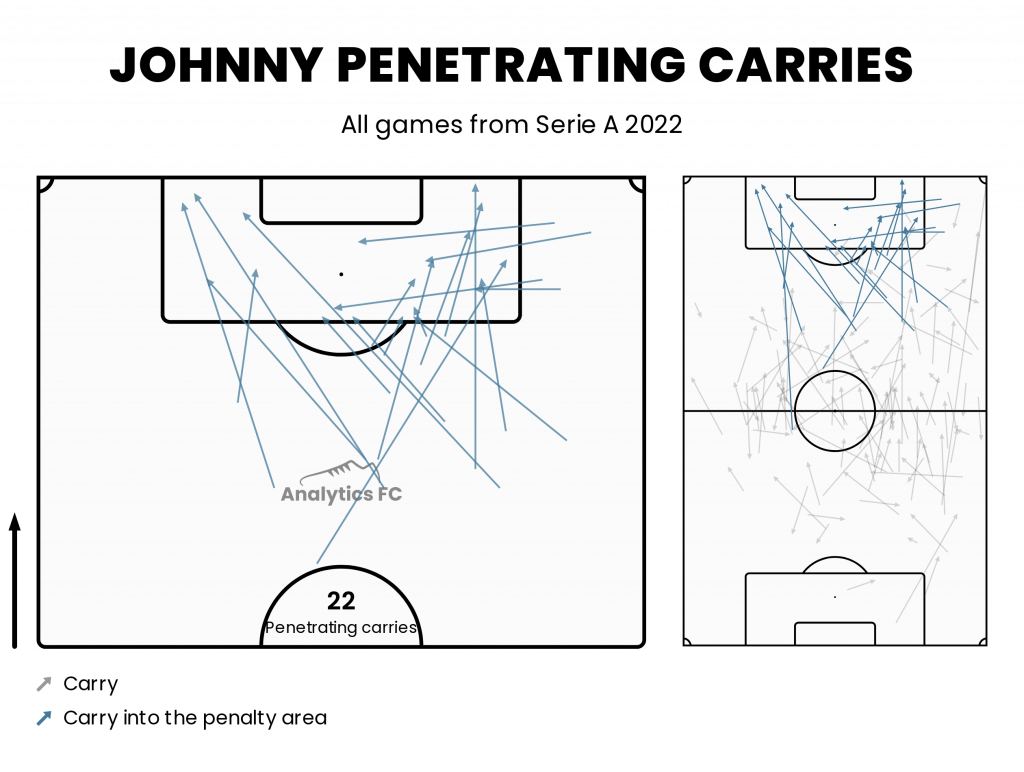
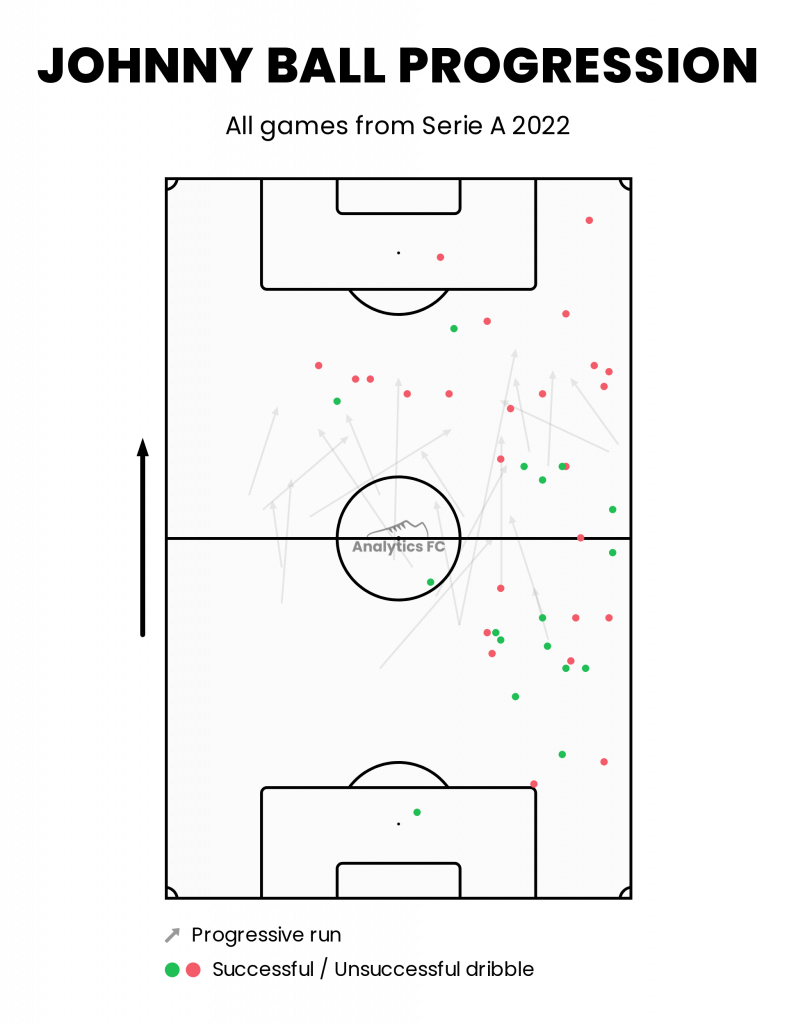
While not a defensive midfielder, Johnny’s defensive output is good, especially high up the pitch where his pressing can open up dangerous opportunities for his team.
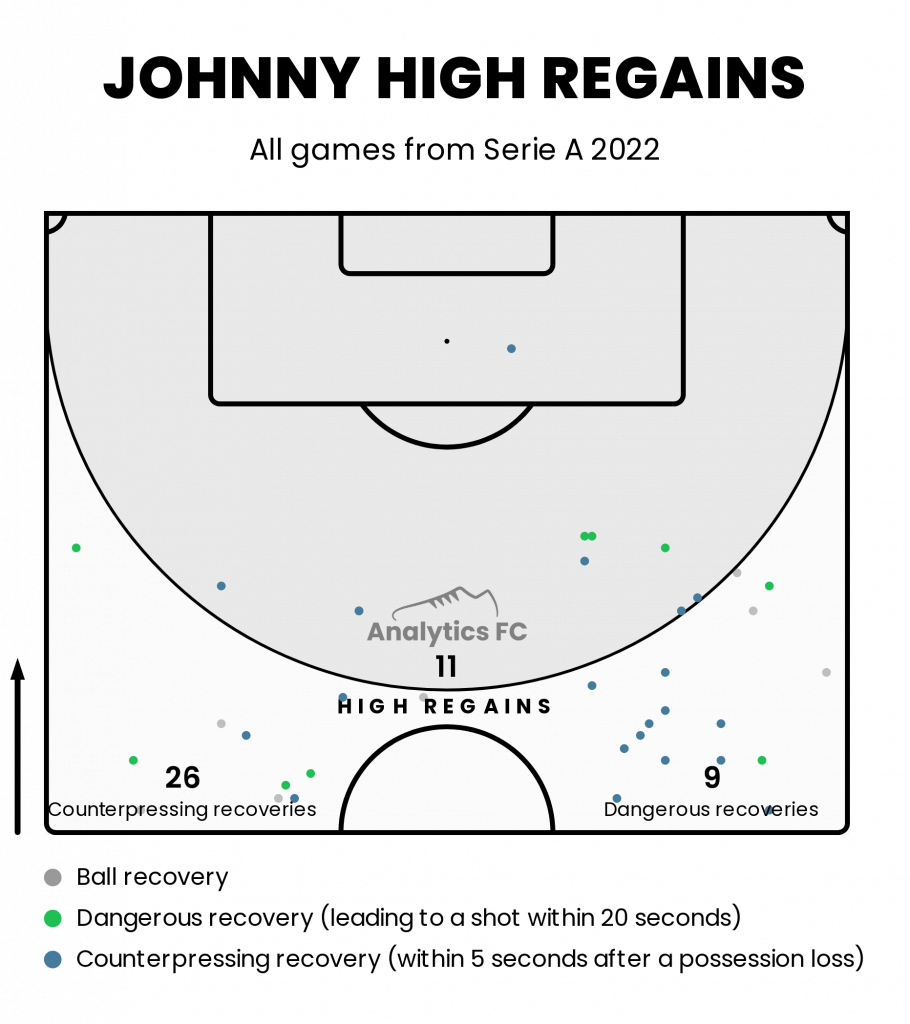
There seems little that this energetic midfielder cannot do ably, and, indeed, when compared against players in Europe’s top five leagues many of his numbers show the kind of minimal drop-off that could well be offset by playing within a squad of higher quality. While dribbles, long passing, and defence take a hit, not unlike Martinelli, Johnny’s passing and carrying figures remain extremely strong, suggesting a top 25-30% player in his position across Europe’s top five leagues who has yet to reach his peak.
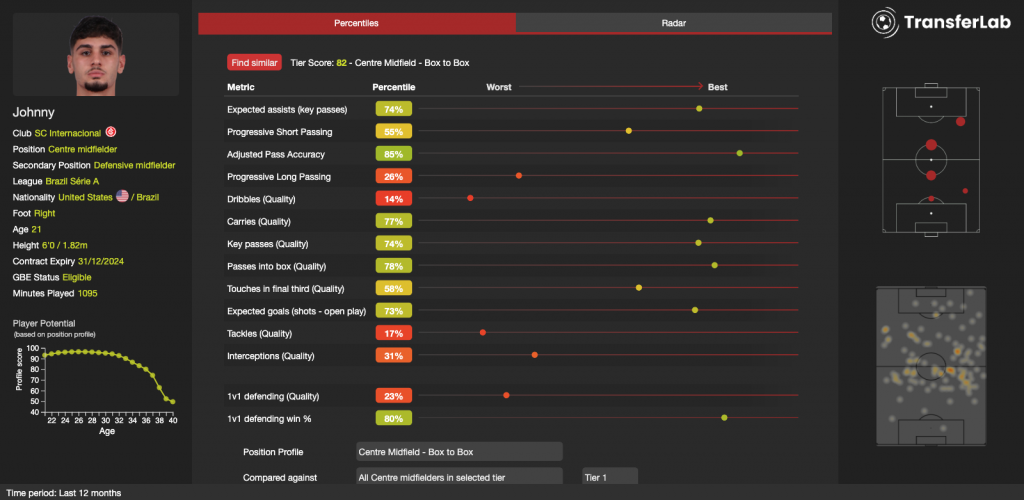
He would suit the kind of team who play a high pressing style with lots of short passes, and midfielders who break from the 8 position to carry into threat areas or offer a shooting option from deep. The most similar player in TransferLab is Brentford’s dynamo Vitaly Janelt, although Johnny looks to have better passing capability.
Conclusion
While the outcome of the Brexit GBE regulations is a massive reduction in the number of players of available, smart clubs will be looking outside the traditional areas of recruitment to find quality. While many Brazilian players move first to Portugal for reasons of cultural and linguistic fit, there are players in the Brasileirão who could comfortably move to clubs in England or Scotland not be out of place, tactically or technically. UK football clubs looking to exploit this previously under-scouted league will not be disappointed.
Header image: Shutterstock/A. Paes














